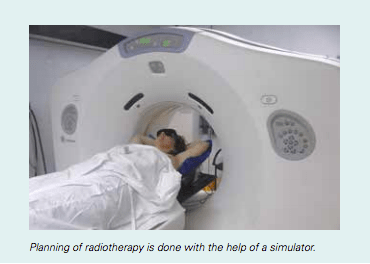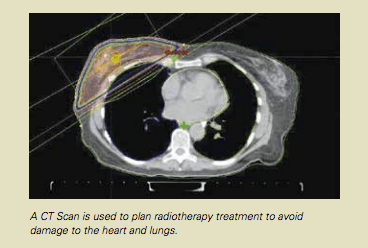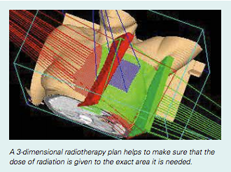What is radiotherapy?
[This information guide is also available in PDF format to download.]
Radiotherapy is treatment that uses radiation to destroy cancer cells. It works because cancer cells are more sensitive to radiation than normal cells. If a small dose of radiation is given each day over several weeks, normal cells can recover from radiation, but cancer cells are less able to recover. For breast cancer, radiotherapy can be given to the breast, chest or lymph nodes to reduce the chance of cancer returning to the area after surgery. Less commonly it can be used to treat the breast or lymph node areas instead of surgery.
How is radiotherapy given?
Radiotherapy for breast cancer usually involves treatment for 3 to 6 weeks. The first visit is a planning session. Daily treatment sessions begin a few weeks later.
Planning session
During a planning session, your treatment plan will be carefully developed to make sure that the radiation is directed to the breast or chest and that it avoids damage to the skin, heart and lungs. A radiation therapist will ask you to lie on the flat bed of a simulator and will do a CT scan of your chest in the treatment position. The radiation oncologist and radiation therapist will work with a physicist to develop an individual radiation treatment plan for you. They may make 2-3 permanent marks (tattoos) about the size of a pinhead on your skin. The planning visit takes about 30 minutes.
Treatment sessions
After the planning session, a radiotherapy plan is developed on a computer and approved by your doctor. There may be a gap of 1 to 3 weeks until treatment begins. Daily radiotherapy is given by a machine called a linear accelerator. You will be treated at approximately the same time each day. Treatment takes about five minutes each day, but you will be in the treatment room for about 10 to 15 minutes while the therapists help you into the correct position. You may be at the hospital for up to one hour each day if other patients are waiting, or need urgent treatment, or if the treatment machine needs to be adjusted.
Treatment is given nine or ten times each fortnight, but is not given on weekends or public holidays. Once a week during treatment, your radiation oncologist and/or their registrar (a qualified doctor training to be a specialist) or a breast care nurse will check to see how your skin is reacting to the radiation treatment and answer any of your questions.
An extra treatment called a ‘boost’ may be given during or immediately following the treatment to your whole breast. It is given where the tumour started. Treatment normally takes 3 to 6 weeks.

Will I feel anything?
Radiotherapy does not hurt, and you will not feel any pain while you are having treatment. You may hear some noise from the machine. You will be alone in the treatment room while the machine is working, but the radiation therapist will be able to see you on a monitor screen and hear you if you speak. You will need to lie still, take a deep breath and hold while you are having the treatment.
Radiotherapy does not make you radioactive. It is quite safe for you to be with other people, including children, during and after your treatment. It is safe for you to have normal contact with people including hugging and kissing.

What do I need to bring to the planning appointment?
Make sure you bring your mammograms and other X-ray films to your planning appointment. Write down any questions or concerns that you have, and your doctor will discuss these with you.
How will radiotherapy affect my daily life?
You will need to travel to the treatment centre each day around the same time. If you live near the centre, you may be able to continue to work. If you need to travel a longer distance for treatment, you may feel too tired to keep working. The treatment centre will try to arrange a treatment time to suit your schedule. If you want to keep working you can ask for an appointment early in the morning or late in the afternoon. You may find it easier to wear a two piece outfit (e.g top and skirt or trousers) to your appointment.
You will not need a special diet or any medications during your course of radiotherapy. You may eat and drink normally, including alcohol in moderation, and continue to take any medications that you have been prescribed. Please let your doctor know if you are taking alternative medications.
You must not become pregnant while having radiotherapy and should take contraceptive precautions. If at any time during your treatment for breast cancer you think you may be pregnant, tell your doctor.

What are the side effects of radiotherapy?
Common reactions
During your course of treatment
- Skin reddening and irritation: slight reddening ofthe skin can develop by the third week of treatment. This reddening usually gets worse towards the end of treatment. The skin reaction usually settles down in the two weeks after your therapy finishes. You may apply sorbolene cream to relieve the irritation. Your doctor may be able to prescribe other creams if this reddening gets worse.
- Tiredness: you may feel tired during the course of treatment. This may take a few weeks to settle after the treatment has finished. If you have also had chemotherapy this may last for a number of months.
- Aches and pains in the breast: most women feel twinges in the breast. These are usually minor and do not need any pain medication. This discomfort is normal and may occur on and off for one or more years after you complete your treatment. Sometimes you lose some feeling in your nipple after treatment.
- Loss of hair: you will not lose the hair on your head, but if your armpit region is treated, you will lose underarm hair. The hair is unlikely to re-grow.
- Sore throat: if the lymph nodes (‘glands’) at the base of your neck need to be included in the treated area, then your throat may become sore during treatment.
After your course of treatment
- Discomfort and sensitivity in the treated area: this may develop on the breast or the muscle underneath the breast (pectoralis major muscle).
- Increased breast firmness: mild to moderate firmness that needs no treatment.
- Swelling of the treated breast: mild swelling may last for up to one year or more.
- Pale skin colour: pale skin on the nipple and areola (coloured circle around your nipple).
- Prominent blood vessels can develop on the skin in the treated area.
Uncommon reactions
During your course of treatment
- Skin blisters: occasionally the skin in the armpit and underneath the breast blisters. Usually the blistered skin heals in one or two weeks. Please ask your radiation therapist, nurse or doctor for advice if you develop skin blisters.
- Nausea: nausea is not very common, but ask for medication if you feel sick during or after your treatment.
After your course of treatment
- Rib fractures: fewer than one in 200 women who have radiotherapy develop a fracture in the treated area. You may feel a sharp pain along the rib cage in the treated area, and your doctor may ask for an X-ray to see if your rib is broken. You may need some temporary pain medication and the rib fracture will heal without any other special treatment.
Rare reactions
- Lung inflammation and scarring: your breast is in front of your chest wall and lungs, so a small part of the lung must be included for treatment in order for the whole breast to be treated. About one or two women in 100 who have radiotherapy develop lung inflammation between one month to six months after the therapy has finished. You may be excessively tired, have a fever, be short of breath or have a cough. If you have these symptoms, your doctor may arrange an X-ray or CT scan of your chest and prescribe a course of antibiotics and corticosteroid tablets.
Extremely rare reactions
- Excessive shrinkage of the breast: about 1 in 1000 women may be more sensitive to radiation than normal. This will cause the breast to shrink. There is no way to know if this will happen.
- Damage to the heart: during breast radiotherapy, a small dose of radiation reaches the heart. This is more likely when the left breast is being treated for cancer. Some, but not all, studies have found an increased chance of a heart attack after radiation. Careful CT planning will substantially reduce or eliminate this risk.
- Other cancers: women who have had radiotherapy for breast cancer may rarely develop a serious cancer, such as a sarcoma, anywhere in the path of the radiotherapy beam. This is very rare and it can occur even after a mastectomy. This happens in 1 in 5,000–10,000 women, usually five to ten years after treatment.
Some reports have shown a very slight increase in the risk of lung cancer. More research is needed in this area. If you smoke it is important that you stop.
What should I do for my skin?
If you feel any skin discomfort in the treated area, tell your radiation therapist, nurse or doctor.
Do not hesitate to ask questions or let them know if you have any concerns.
You may find the following suggestions helpful for the care of skin that is exposed to radiation.
-
You may wash the treated skin with warm water and a very mild soap such as Johnson’s baby soap ®, Pears ®, Dove ® or Neutrogena ®. Sorbolene cream is safe to use, but do not use cosmetics, perfumes or other lotions.
-
Pat the skin dry; do not rub it.
-
You may continue to use deodorant.
-
Do not shave under the arm on your treated side with a razor blade. You may use an electric shaver.
-
Your skin may become dry because the sweat glands may produce less sweat. Apply sorbolene cream to the areas of dry skin.
-
Do not wear tight-fitting clothing that could rub, press against or irritate your skin. You may find that cotton T-shirts, singlets and old-style, loose-fitting cotton bras are more comfortable.
-
If you have large breasts, a supportive bra may help lift your breast off your chest, and this reduces rubbing and any skin reaction in the fold between your breast and chest wall. A pad between your bra and the skin may help to protect this area.
-
If you are having treatment to the area above your collar-bone, apply sorbolene cream to this area and to your upper back. Sometimes a skin reaction develops on your upper back skin, where the radiation exits.
-
If your skin peels, special creams used for burns, prescribed by your doctor, can be applied with a dressing to protect your clothing.
-
Do not expose the treated skin to excessive temperatures, including heat and sun lamps, hot-water bottles, electric blankets, saunas, spa baths and ice packs during your course of radiation treatment.
-
Whenever the treated skin is exposed to sunlight, use sun protection cream and cover your skin with light clothing.
-
Swimming in chlorine pools is not recommended.
After radiotherapy, when all the side effects from the radiation treatment have settled down (usually within two weeks), you can resume your normal skin care routine. You may use the lotions, creams, soaps and deodorants that you used before your therapy started
Who can I speak to?
Very experienced staff members are available at the treatment centre. For some women, treatment for cancer is a challenging experience. Please tell your nurse, radiation therapist or doctor about any concerns that you have. The Specialist Breast Care Nurse is also available to talk to you.
Useful contacts/websites
| Cancer Australia | canceraustralia.gov.au |
| Cancer Council | cancer.org.au |
| Cancer Council Helpline | 13 11 20 |
| Breast Cancer Network Australia (BCNA) | 1800 500 258 bcna.org.au |
Version 8 – WSP 044 April 2023
© Westmead Breast Cancer Institute
[This information guide is also available in PDF format to download.]
